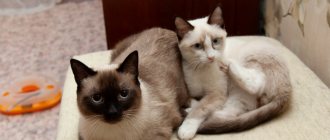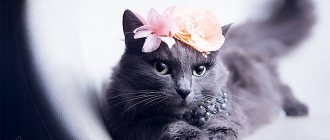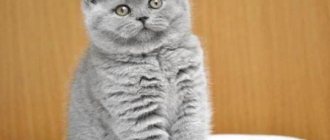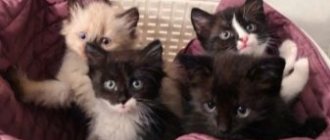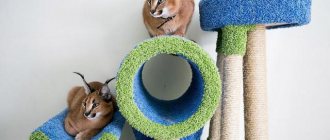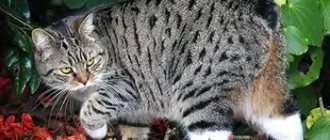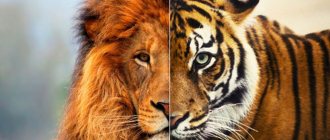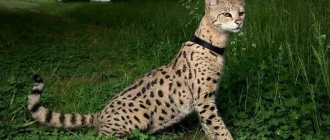There are about 250 cat breeds in the world, but 10 of them can be called real giants. They live on five continents, and each part of the world boasts its own breed, which was bred in recent decades or formed in an indigenous form in natural conditions.
There are various rumors about the habits of large cats, but according to reviews from owners, in real life they are just as affectionate and sociable as their smaller relatives.
Leaders in the nomination “Largest cat breed”
Today, two fierce rivals vying for the title of “largest domestic cat breed” are: the Savannah and the Maine Coon.
It is no secret that the third competitor intended to be a representative of the Asher family. But, as it turned out, this breed was a fictitious creation of a felinologist and, as such, does not exist, but was simply given out by Savannah under the guise of an allegedly new unique Asher individual.
After exposure, this participant was disqualified from the competition, but it is worth knowing about some nuances regarding this case. Indeed, to this day no court decision has been made regarding this breed.
A thorough genetic examination is being carried out to reveal the truth about the creation of the Ashera. The owner of this newest species, Brady, assures that these two cats are completely different breeds.
He explains that the only similarity between these breeds is the serval gene, and the Asher also contains the genes of an Asian leopard cat and a predatory cat (see photo of an Asian leopard cat).
Temminck's cat
Asian golden cat on the hunt
It is also called the Asian golden cat and catopuma. Temminck cats are not common in Russia, but a couple live with famous politicians. But in Asia, especially in Thailand and Tibet, animals are quite domesticated. In addition to the above, Nepal, India, Southern China and mainland Malaysia became the habitat of golden cats.
Representatives of the species are beautiful, but characteristic creatures. If these beauties are kept, it is in private homes. It is possible to train an animal when it is adopted as a kitten; in adolescence there is no point in trying. As for adults, they will not make a cute pet. It's worth starting with cat activity at dusk and early morning. And no one has canceled the predatory character.
Asian golden cats feed on birds and small rodents. Due to the mobility of pets, they need the territory of a private home.
And the most important thing is the size of the animals. In terms of height at the withers, cats will give a head start to a German shepherd - from 56 cm and above. Weight fluctuates around 9-16 kg.
I place – Savannah breed
Breed characteristics
- This species is considered a large cat in terms of weight, and is also distinguished by the height and length of its body.
- Weight: 12-15 kg (about the same weight as Maine Coons, although it is known that there are other representatives that reach more weight, about 20 kg).
- Height: about 60 cm.
One can argue for a long time about whether this breed belongs to the domestic representatives of its own kind, since it was generated by a combination of the African serval species with a simple cat. But if you think about it, the ancestors of most domestic pets were wild.
The heiress of this breed, a cat named Trouble, was the first to get into the Guinness Book of Records. Her height then reached 48 cm at the withers. Therefore, she had the title of the highest.
In addition to these achievements, this type is, by far, the most expensive compared to others, the maximum price is twenty-five thousand dollars. Also see what is the most expensive cat in the world.
The largest domestic cats in the world
If an ordinary cat becomes fully grown by the age of 2, then representatives of the largest breeds of cats grow up to approximately 4 years. However, they are divided into two categories:
- Aborigines who have gone through a centuries-old evolutionary path and adapted to the natural conditions of their region. Such cats, despite their late maturation, enter reproductive age very early. The need to quickly acquire offspring was dictated by the specifics of survival - you need to continue the family before you die in a fight with a competitor or become weak from hunger.
- Modern breeds of large domestic cats, the selection of which took place in nurseries. There is necessarily a relationship with one of the representatives of the first group (or wild, untamed predators). In this case, such a property as late maturation is not transmitted at the genetic level.
The first ones became big in order to survive, and the second ones were created by people who wanted to get a pet with the appearance of a wild animal.
Chausie (housey)
This representative of the family was bred by felinologists who were creating new large breeds of cats. The hybrid's ancestors include a wild jungle cat and an Abyssinian cat.
The first experiments began in the 60-70s of the last century; they quickly obtained offspring with the given characteristics, but they managed to register the breed only in 1995.
Such a long period can be explained simply - the crossbreed never became a cat with a stable genotype. She constantly needs a rush of “wild” jungle cat blood, otherwise the chausie loses the qualities that the breeders tried to program.
Within this large breed, 4 types of hybrids are considered, which are classified depending on the level of relationship with wild animals:
- F1 – direct descendants of wild cats;
- F2 – at least 25% relatedness;
- F3 – heirs of F2 or any other type, and have 12.5% wild blood;
- F4 – less than 7% pure blood from native breeds.
True Hausie F1 and F2 are kept only in open enclosures, given their natural qualities and predisposition to aggression. They are agile, intelligent, attached to their owner and, with the right attitude, interact normally with people.
This is interesting! The weight of an adult castrated male Chausie exceeds 7.5 kg. Cats weigh no more than 6 kg on average.
Carthusian (chartreuse)
The history of this large domestic cat began at least 6 centuries ago. The initial selection took place under the supervision of Carthusian monks in the foothills of the Alps, near the Chartreuse massif, where the monastery of the founders of this order is located.
The first large cats of this breed were green-eyed and only in the last 100 years the color of the pupil changed to orange-honey.
Chartreuse cats are very smart; for example, such a cat can learn to open doors and bring slippers to the owner.
This is interesting! A notable feature of large Chartreuse cats is their voice. He is quiet, soft, and sometimes animals are generally mute by nature. They say that the monks of the Carthusian order were also not distinguished by their eloquence.
Siberian cat
This cat breed is rightly called aboriginal in the Urals and Siberia. At first it was classified as Bukhara - this is how Siberians were mentioned in medieval charters and lists.
Among the large breeds of domestic cats, the Russian branch has the most beautiful coat - long or medium, with a thick fluffy collar, “breeches” on the hind legs and a double undercoat. In warm weather, the fur coat can take on a summer look - it becomes thinner, but with the arrival of cold weather, the undercoat thickens and reliably protects the cat from hypothermia.
Read the detailed article – “About Siberian cats”.
Like most native cat breeds, Siberians mature late. By the age of one year, males gain up to 7 kg, but continue to “get heavier” for several more years. Therefore, the weight of an adult animal often exceeds 10 kg.
This is interesting! Siberian cats often show signs of nepotism. If the father has the opportunity to communicate with the kittens, he devotes a lot of time to them and helps the female cope with disobedient cubs.
Turkish van
The homeland of the next representative of the list of the largest cats is the territory adjacent to Lake Van. This is where the name of the breed comes from.
The Turkish Van differs from other large cats in the following ways:
- An unusual color, which is entrenched in felinology in the same way as the Siamese color point.
- This cat loves heights, so he often climbs onto eaves, cabinets and doors.
The color of the Turkish Bath is predominantly white, with red pigmentation present on the tail and around the ears.
The height of a big cat reaches 1-1.2 m, and the average weight is close to 8 kg.
This is interesting! Van usually becomes attached to one owner and runs after him, brings small objects, and he also loves water and willingly bathes.
Norwegian Forest: Viking cat
The pedigree of this cat from Northern Europe goes back 10 centuries. According to legend, these animals accompanied the Vikings on the American Expedition at the beginning of the last millennium, and later took part in the formation of local breeds of big cats.
By their constitution, large Norwegian cats are very similar to Siberians. They have a thick undercoat and semi-long coat. Norwegians are distinguished from other breeds by a rich collar on the neck and warm pants on the paws, as well as whiskers and thick hair inside the ears.
The largest cats of the Norwegian breed reach 40-45 cm at the withers, and their average weight is 10 kg.
British Shorthair
British Shorthairs are considered the healthiest breed, since these cats are more likely than others to live to a ripe old age. They have excellent immunity and, due to the conditions of breeding, are very limited in the choice of partners with different blood.
Another difference between the British cat and other large breeds is its early maturation. At the age of 1 year, the weight of a British cat can be 9 kg, while sterilized pets can weigh more than 10 kg. But later their development is not so noticeable, and by 2-3 years they do not gain either weight or height.
Important! Huge British cats are very capricious. They love solitude and cannot stand violence. If personal space is violated, such a cat is capable of showing aggression towards others.
Ragdoll
Several breeds became the ancestors of the ragdoll. The mother cat from which the line began was of Persian-Angora blood, and the partner was a Burmese cat. As a result of the crossing, large kittens were born, which later demonstrated unusual character traits, which were later consolidated in the new breed.
Due to the unusual relaxation of the muscles, this cat got its name (ragdoll translates as “rag doll”).
We recommend the article – “Ragdoll cats”.
The process of the official formation of the breed is also interesting. Breeder Anne Baker did not follow the standard path of registering a new species with international associations. In the early 70s, she founded the Ragdoll brand, created her own association, which began breeding these large cats, and established very strict selection rules. Only 5 years later, amateurs demanded that the official felinological communities recognize the new breed.
Adult female cats weigh about 7-8 kg, in contrast to males, whose body weight reaches 10 kg. The body length of large specimens exceeds 1 meter.
Ragamuffin
Another breed that was developed by crossing Ragdolls with Persians, Himalayans and large outbred cats.
The Ragamuffin allows almost any color combination - from solid solid to tortoiseshell, white spotted, chinchilla and others. By constitution, this giant is similar to its ragdoll ancestor, the only difference is the shape and color of the eyes.
An interesting and useful article about Ragamuffin cats.
Too light a bone and too little weight for a Ragamuffin are disqualifying signs. This is how breeders encourage the breeding of large domestic cats.
Savannah
The list continues with a hybrid of an African serval and a domestic cat. Like any other representative of interspecific crossing, a large savannah is marked with the designations F1–F7. The higher the number, the less wild blood a healthy purebred cat has.
The Savannah has long legs with rounded paws, an elongated body and a high-set head. The characteristic “wild” spotted color and large ears immediately indicate a descendant of wild hunters from the African desert.
This name of the big cat breed is often used with the meaning “most”. Not only does the Savannah rank high in weight and size (at the withers it reaches 60 cm, and on the scale it usually shows 10-12 kg), but for several years it has held the title of the most expensive cat in the world.
This is interesting! Despite its pedigree, the large savannah is distinguished by a very kind disposition and lack of natural aggression. F1–F3 hybrids are recommended for aviary keeping, and the lower percentage of African Serval blood makes it possible to keep animals at home without any problems.
Maine Coon
The native American raccoon cat became famous for its gigantic size. He is among the pets whose parameters can only be described in superlatives:
- The longest - the body length of the Maine Coon often reaches 120 cm.
- The heaviest - neutered - weighs about 14 kg.
- The most trainable - can carry out the owner's commands.
- The best hunter - the qualities of a rat catcher at one time saved this breed of cats from complete oblivion.
And the large purebred Maine Coon, which heads the top of the largest domestic cats, is sometimes called a pet without flaws. Unless, of course, you count the abundance of fur that he leaves behind during the molting period.
2nd place – Maine Coon breed
Description of the breed
- Maine Coons are not only large cats, but also charming pets with sharp tufts on the tips of their ears, like lynxes, fluffy fur and a variety of colors.
- Weight: from 8-15 kg.
- Height: up to 41 cm.
- Stewie, a purebred cat from this region, broke the record and became the longest cat in the world. The length from the tip of his fluffy tail to his nose was 123 cm.
Ragdoll
Height: 30–40 cm
Weight: 5–10 kg
Ragdolls have an interesting feature - when held in their hands, they relax and fall into a state of stupor. Loyal to their owner, like dogs, they follow him everywhere. They are distinguished by a peculiar meow, more like the crowing of pigeons. They are in good health, but sometimes have heart problems.
III place – representatives of the Chausie breed
Description of the breed
- In addition to the above two legitimate contenders for the title of “biggest cat,” one can imagine a representative of the jungle cats, the Chausie breed (also known as Chausie or Houseie).
- Weight: reaches 18 kg.
- Height: 40cm.
The main goal for creating this breed by crossing a jungle cat and an Abyssinian (see all photos of a jungle cat) was the idea of the breeders to get a variety of domestic cat to protect wild cats from being imprisoned in captivity.
See also what is the largest cat in the world, its weight and dimensions.
The goal was achieved and today the Shawzi gets along well with people and is quite loving towards them.
In the wild and at home
There are people who like to keep a truly dangerous wild animal at home. It is believed that representatives of the cat family are best suited for these purposes. Considering that attempts to cross a wild cat with a domestic cat do not always lead to satisfactory results, the most desperate cat admirers decide to purchase a wild individual.
This decision can hardly be called reasonable, because living in direct contact with a predator can lead to unpredictable consequences. Having chosen such a pet, you need to carefully consider the conditions of detention and safety rules for it and, of course, for all household members.
So, wild cats that can theoretically be kept at home:
- Jaguarundi is an unusual cat with a face that resembles a weasel. The animal is native to South and Central America, whose closest relative is the puma. Despite such a serious relationship, the jaguarundi gets along well with humans. Cats are diurnal, quickly get used to their owner, and are easily tamed. The average weight of a male is 8 – 10 kg.
Jaguarundi
- Geoffroy is a relatively small cat native to South America. In appearance and habits it resembles a leopard, but is much smaller in size. The weight of an adult animal is about 5 kg; large cats can weigh 8 kg. Geoffreys are easy to train, especially if training begins at an early age. Cats are very affectionate, playful, and easy to make contact with. They can live both in a house or apartment, and in a cage on the street.
Geoffroy
- The caracal is another wild cat that lives near humans. Caracals can be trained, but it will take a lot of time and a lot of effort is required to get noticeable results. Keeping such a pet is expensive, and the animal is not suitable for living in a home. He requires a spacious outdoor enclosure. An adult male reaches a weight of 20 kg.
Caracal
- The Asian leopard cat is one of the most popular wild animals to keep as pets. Outwardly similar to a leopard, only smaller in size. The weight of an adult cat is 10 - 15 kg, with a body length of 43 - 45 cm. She gets used to living in a house quite easily if she is provided with suitable conditions. But keeping it in an outdoor enclosure is optimal.
Asian leopard cat
- Serval - ranks first in popularity among wild cats kept at home. The animal has a friendly disposition, they are capable of strong attachment to a person and remain devoted to him for many years. In terms of habits, the serval is in many ways similar to a dog. Very smart, easy to train. Can become an excellent protector for the owner. With proper upbringing, he grows up obedient, affectionate, and faithful. The weight of an adult male ranges from 9 to 18 kg.
Serval
The liger is considered the largest wild cat in the world. This animal is a hybrid resulting from the crossing of a lion and a tigress. Ligers are not found in the wild because lions and tigers have different habitat regions. The average weight of a male is 340 kg, height at the withers is 1.6 - 1.7 m. The Hercules liger is officially recognized as the largest representative of the breed. His weight is more than 420 kg, with a height of 1.86 m.
IV place - charming ragdoll cats
Description of the breed
- Although the Ragdoll cat breed differs in size from ordinary cats, it is difficult to call it gigantic. Considering that the big ones in this breed are mostly males, and not all of them.
- Weight: 9 kg.
- Length: 1 meter (record).
- These cats, especially their breed, are also called rag dolls. And all thanks to their genetically built-in passionless ardor, cuteness and non-aggressive behavior.
Chartreuse
The ancestors of the Chartreuse are unknown. But felinologists associate the appearance of the breed with the Crusaders and the Order of the Carthusians. Chartreuses accompanied ships to Africa, saving ship supplies from rodents.
View this post on Instagram
A post shared by Victor Ray (@v1cr4v)
The cat has 2 features. First of all, there is a pronounced hunter’s instinct. Therefore, the animal is not recommended to live together with rodents and birds. Another feature is long-term growth. The pet grows up to 5 years. The height of an adult Chartreux is 30 cm, weight is 7–9 kg for a male and 4–5 kg for a female.
V place – short-haired pixie-bob (domestic lynxes)
Description of the breed
The next, but not the last, representative of the cat giants is the artificially bred short-haired pixie-bob, the domestic lynx. These cats are not much different in appearance from lynxes.
They are like representatives of these animals, but in miniature: the same sharp tassels on the tips of the ears and color. And also the pixie-bot will have a short tail (5 cm, sometimes 7-10 cm)
- Weight: males - 8kg, females -5kg
Forest Norwegian
In our area, Scandinavian forest cats are rare; the breed is common in the countries of Northern Europe. The weight of the animal reaches 10 kg. It is considered the national breed of Norway. Cats have a quiet, good character, are very sociable, and quickly become attached to a person.
The price of a kitten starts from 10,000 rubles; for trained exhibition participants you will sometimes have to pay 30,000 or 40,000 rubles.
VI place – representatives of the North, Siberian cats
Description of the breed
- Representatives of the breed are Siberian cats from Russia. Among their fellow tribesmen, they stand out for their size.
- Weight: for males the maximum reaches 12 kg, and for females up to 5-6 kg.
- The peculiarity of this individual is their external fluffy and nice appearance. They are like a big and bright ball of affection. At the same time, scientists guarantee that Siberian cats are among the hypoallergenic breeds, which means they do not provoke an allergic reaction in sensitive people.
British Shorthair
This breed of cats reaches 7-8 kg, have a friendly character, although it is believed that the British are arrogant, independent and “walking on their own” cats.
They have high intelligence, playfulness, and, of course, independence; they will not tolerate bad treatment. The average price of a British shorthair cat is about 12,000 rubles.
Curious cases
One of the criteria for giant cats is also their weight. And in this case, the winner was none other than SpongeBob, who was included in the Guinness Book of Records under the category of the most plump cat.
His weight was 15kg. Today, this cat had to be put on a serious diet. And according to a certain decision of the book’s founders, this section of the record was withdrawn for the safety of the feline representatives, so that breeders would not sacrifice their health to win.
Over a long period of time, similar nominations were awarded several times, and the most impressive result was that of the Austrian cat Khiimiya. He weighed about 21 kg and subsequently died from obesity.
Of course, having the biggest cat in the house is nice and partly becomes pride, but the main thing is, first of all, love for the animal and caring for it.
Chausie
It is considered not only one of the largest, but, at the same time, the rarest breed, the weight of which can reach at least 14 and a half kilograms.
The breed was born in 1990 and is a hybrid of an Abyssinian cat and a jungle cat. The jungle cat prefers to live in swamps, which is why it is also called the swamp lynx.
As a result of hard work, breeders managed to get a cat that has the power of a predator and the docile nature of a domestic cat. Chausie cats are quite strong cats, with an athletically complex body, a large (comparatively) head, large ears, and green or yellow eyes. Despite such external characteristics, the breed is devoted to its owner and feels great around children.
Ragamuffin
California is considered the birthplace of this breed, and it was born as a result of the efforts of Ann Baker, who decided to modify the Ragdoll. So she began to crossbreed the Ragdoll with other cat breeds, such as the Persian, the Yard Longhair, and the Himalayan.
As a result of these efforts, a breed was born that was called “cherub,” but at the last moment it was renamed and began to be called “ragamuffin,” which means “ragamuffin.”
Adults weigh at least 10 kilograms and acquire impressive sizes, although they mature only at 4 years of age. The breed does not have a beautiful, proportional physique, but it is distinguished by a variety of coat colors.
